How can I use Knovel's Unit Converter?
Last updated on September 02, 2025
Knovel's Unit Converter enables any user to quickly convert any unit of measurement—or any combination of units—into another unit in just a few simple steps. Choose from a list of approximately 1,000 unique units for approximately 90 properties. Plus:
- Create custom units specific to your profession.
- Automatically calculate complex values you want to convert.
- Adjust the precision level and display of your converted measurements.
- Interactive keyboard speeds your workflow and minimizes typing errors.
- Share the Knovel Unit Converter URL and your conversions with colleagues or team members.
- Choose from U.S. Custom and metric units.
- Knovel subscribers get additional customization functionality.
How
Click on one of the below topics to learn more:
Knovel Unit Converter Snapshot

Follow these steps to convert values from one unit to another:
- Enter a numeric value in the 'Input value' field.
- Enter a unit of measurement in the 'Input Unit':
- Click 'Select Input Unit' to browse alphabetical lists of approximately 1,000 units and 90 properties; or
- Click 'New Unit' to add a unit, which you can create with help from a virtual keyboard that allows you to enter common mathematical symbols, prefixes, and equations.
- Enter a unit of measurement in the 'Output Unit' field:
- Click 'Select Output Unit' to browse alphabetical lists of approximately 1,000 units and 90 properties; or,
- Click 'New Unit' to add a unit, which you can create with help from a virtual keyboard that allows you to enter common mathematical symbols, prefixes, and equations.
- Click 'Convert'.
Entering Values of Units to Convert from

- Enter a value for the unit you wish to convert in the 'Input Value' field.
- Enter a single numeral or;
- Enter a combination of numerals, mathematical operators, and functions, including trigonometric functions, in standard or scientific notation.
- Do not use commas or spaces for separation. The value will be calculated automatically.
Entering Units (to convert from, to convert to)
- To enter units manually

Type the unit symbol or name in the 'Input Unit/Output Unit' field. Unit symbols/names will display in the field as you type; scroll through the list of available units and click 'Enter/Return' on your computer to select the desired unit. Type your own unit in the fields. Be sure the unit is based on existing Knovel Unit Converter units and math operators +, -, *, /, and ^; and adheres to the () syntax rule.
Note: Please be sure to enter specific syntax into the 'Input Unit' field to generate an accurate unit conversion. Misplaced symbols will result in inaccuracies. For example, if you wish to enter the unit of Thermal Conductivity represented as 'W/(m*k),' be sure NOT to enter the following:
- 'W/m*k' - the Unit Converter will assign K (Kelvin) to the numerator rather than the denominator
- 'W/mK' - the Unit Converter will interpret the denominator as mili Kelvin (1,000 degrees mili Kelvin equals 1 degree Kelvin)

- To enter units using a list of units and properties

To find an available unit by browsing an alphabetical list of units or properties:
- Click the 'Select Input Unit/Select Output Unit.'
- Click the 'UNIT SYMBOL (NAME)' or the 'PROPERTY' tab.
- Filter lists by 'U.S. Custom' or 'Metric units' using the 'Show units' options.
- Use the A-Z tabs at the top of the list to browse available units/properties; click the arrow next to 'UNIT SYMBOL (NAME)' or 'PROPERTY' to sort in ascending or descending order. Please Note: clicking the omega symbol above the unit list will display units beginning with non-letter characters.
- After selecting your desired unit or property, it will automatically display in the 'Input Unit/Output Unit' field.
- Output Unit Autocomplete

The Unit Converter will automatically filter 'Output Units' based on the 'Input Unit' entered.
- Enter units into the 'Input Unit' field either manually or using the 'Select Input Unit' or 'New Unit' tabs.
- Click inside the 'Output Unit' field and an alphabetical list of units will appear that is related to the same property as the entered 'Input Unit'.
- Select the desired unit from the list with your cursor; or, type the first letter or symbol to display all units beginning with that symbol or letter. The list will disappear once you begin typing in the 'Output Unit' field (unavailable units will appear in the list).
Using the Input/Output Unit Keyboard

Use the interactive keyboard to quickly enter—while minimizing typing errors—common symbols and mathematical operators into the 'Input Unit' field. The keyboard is also beneficial when adding a new unit.
- Click the keyboard icon above the 'Input Unit' field to open the keyboard.
- Click the desired keys on the keyboard; selected symbols and operators will display in the 'Input Unit' field, which will also display related symbols and names in an alphabetical list.
Adding New Units (to convert from, to convert to)
Create new units based on a combination of existing Knovel Unit Converter units and is supported by the math operators +, -, *, ^, and /.

- Click the 'New Unit' tab to open an equation builder.
- Click the keyboard icon above the 'Input Unit' field to open the virtual keyboard.
- Using both your computer's keyboard and the 'keys' of the virtual keyboard, enter symbols and numerals into the numerator and denominator fields.
- Click 'Enter' to display the new unit in the 'Input Unit' field.
Changing Display of Converted Values


- To adjust the precision level of converted values, use the '-' and '+' buttons to increase or decrease the amount of significant digits. In the first example—where the value is expressed in the decimal system—4 digits are displayed to the left and right of the decimal point. In the second example—where the value is expressed using base e notation—1 digit is displayed preceding the notational symbol.
- To display converted values in either Decimal or scientific notational systems (log/base 10 and log/base e), click the 'Decimal', 'Sci.10', or 'Sci.e' buttons.
Flipping Units


Double-check your conversions by flipping the units you converted from with the units you converted to. To flip units, click 'Flip Units'. Note that you cannot flip values.
Wire Gauge Measurement

Wire gauge is a measurement of how large a wire is, either in diameter or spanning a specific cross-sectional area.
- Use available gauge and weight charts for measurement conversions involving the following:
- Mild Steel
- Galvanized Steel
- Stainless Steel
- Aluminum
- To view one of the four charts, click the 'Gauge Conversions' down arrow located above the 'Input' section of the converter and select the desired chart.
Sharing the Unit Converter URL and Conversions

Use the icons in the upper right corner of your screen to share a link to the Knovel Unit Converter via email or various social media: Facebook, Twitter, and LinkedIn.
To share a current conversion—which will include the values in the 'Input' and 'Output Unit' fields, sign digits, and notation settings—simply copy and paste the URL.
Using Knovel Unit Converter on your Tablet or Smartphone
The Knovel Unit Converter display on tablets and smartphones differs slightly from the desktop computer and laptop displays due to the size of the screens.
Helpful hints, indicated by question marks, do not display.

- Note that though the virtual keyboard does not display, your smartphone's keyboard can perform the same functions. Keys for the math operators '^, -, ()', and '*' are available on most smartphones. Using the letter keys on your device will automatically enter the operators 'deg, degC, degF', and 'degRa', as well as the prefixes 'd, c, m, n, mu, p, T, G, M, k, h, ' and 'da' into the 'New Unit' numerator/denominator or 'Input Unit' fields.
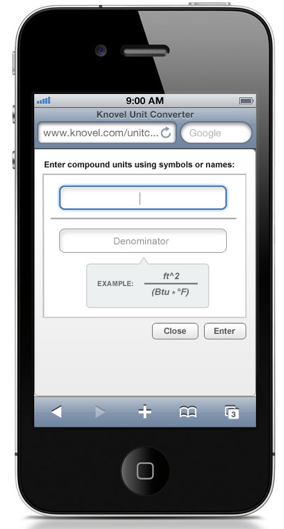
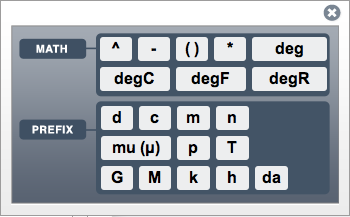
Helpful hints, indicated by question marks, do not display.
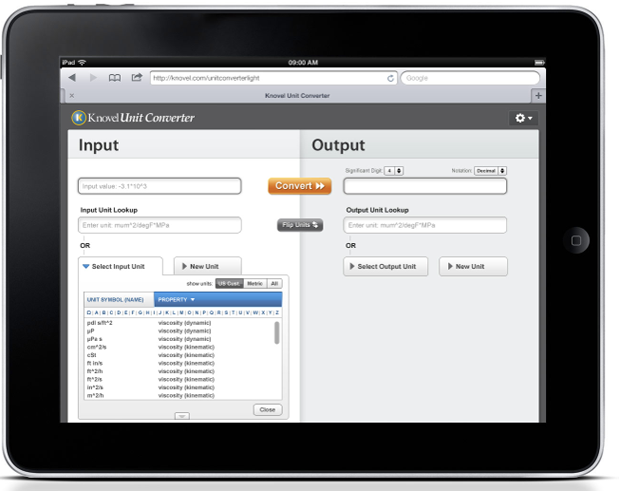
Sample Conversions
A fire protection engineer, in calculating how much water he needs for the sprinkler system in an office building, must convert the area of the basement, 765 square meters, into the equivalent in feet.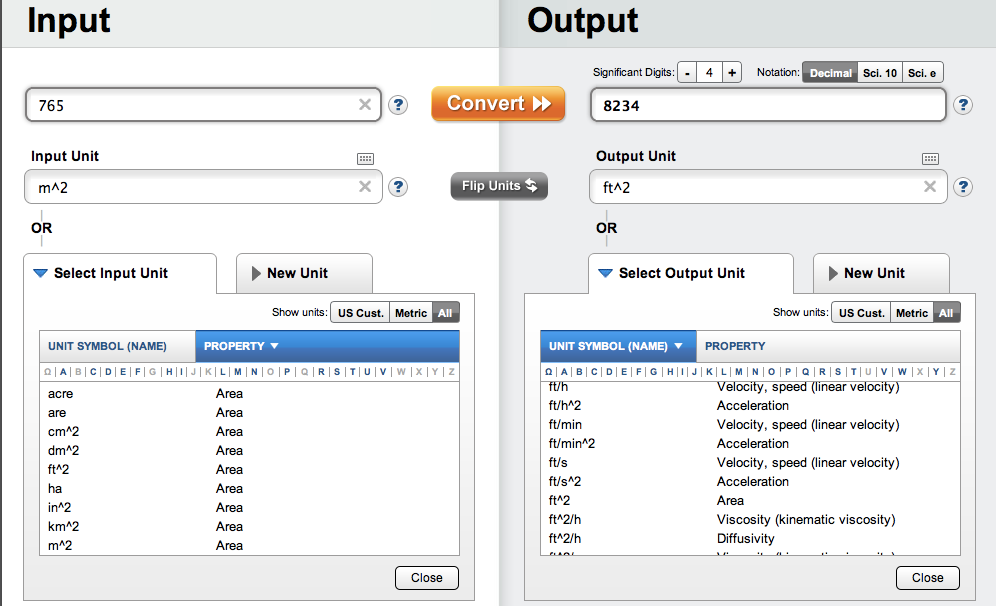
- Enter '765' in the 'Input Value' field.
- Enter 'm^2' in the'Input Unit' field.
- Enter 'ft^2' in the 'Output Unit' field.
- Click 'Convert'
Or
- Enter '765' in the 'Input Value' field.
- Click 'Select Input Unit'.
- Click on the 'PROPERTY' tab; then filter on properties that begin with 'A' for Area, making sure the 'Metric' or 'All' button is selected.
- From the list of symbols, select 'm^2'. Your selection will display in the 'Input Unit' field.
- Click the 'Select Output Unit' tab.
- Click the 'US Cust'. or 'All' button.
- Click on the 'UNIT SYMBOL (NAME)' tab; then filter on units that begin with 'F'.
- Select 'ft^2'.
- Click 'Convert >>'
A student is asked to determine the faster of two velocities: 80 miles per hour or 40 meters per second. To do so, the student should convert miles per hour into meters per second.
- Enter '80' in the 'Input Value' field.
- Enter 'mi/h' in the 'Input Unit' field.
- Enter 'm/s' in the 'Output Unit' field.
- Click 'Convert >>.'
Or
- Enter '80' in the 'Input Value' field.
- Click the 'Select Input Unit' tab.
- Click 'PROPERTY', then 'V' to search units associated with Velocity, making sure the 'US Cust'. or 'All' buttons are selected.
- Select 'mi/h' from the list.
- Click the 'Select Output Unit' tab.
- Click on the 'PROPERTY' tab; then filter on properties that begin with 'V' for Velocity, making sure the 'Metric' or 'All' button is selected.
- Select 'm/s'.
- Click 'Convert >>'
Conversion Involving Trigonometric Functions
Determine the volume of a prism in liters using the dimensions Area and Height in meters. The base of the prism is a triangle, with two sides measuring 2 and 3 meters, and the angle of one of the sides and the third side equaling 120 degrees. The Height of the prism is 10 meters.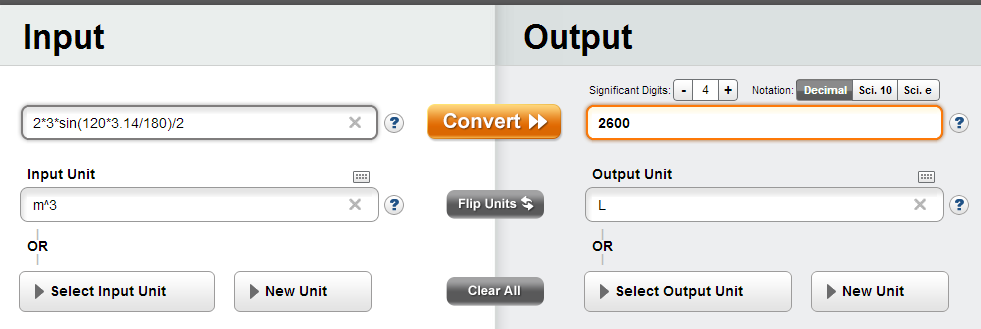
- Enter '2*3*sin(120*3.14/180)*10/2' in the 'Input Value' field, making sure to avoid inserting commas or spaces between numbers and symbols. Please note that the argument value for all trigonometric functions is in radians. If the angle is given in degrees it needs to be translated into radians, such as in this example.
- Enter manually or using the virtual keyboard 'm^3' in the 'Input Unit' field.
- Enter 'L' in the 'Output Unit' field.
- Click 'Convert >>.'
- Adjust the precision level using the 'Significant Digits' buttons.
An engineer must convert the heat of a material (using calories and weight) from Fahrenheit to centigrade.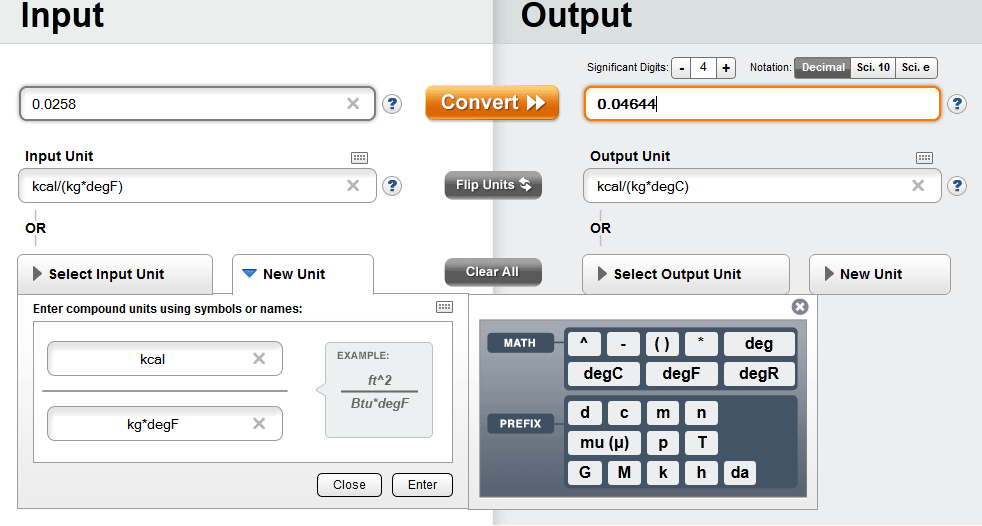
- Enter '0.0258' in the 'Input Value' field.
- Click the 'New Unit' tab in the 'Input' section of the converter.
- Enter 'kcal', for kilocalories, as the numerator and 'kg', for kilograms, as the denominator in the equation builder
- Using the virtual keyboard, click '*' and 'degF'. These will be displayed in the 'Denominator' field.
- Click 'Enter'. The newly created unit will display in the 'Input Unit' field.
- Enter 'kcal/(kg*degC)' in the 'Output Unit' field.
- Click 'Convert >>'.
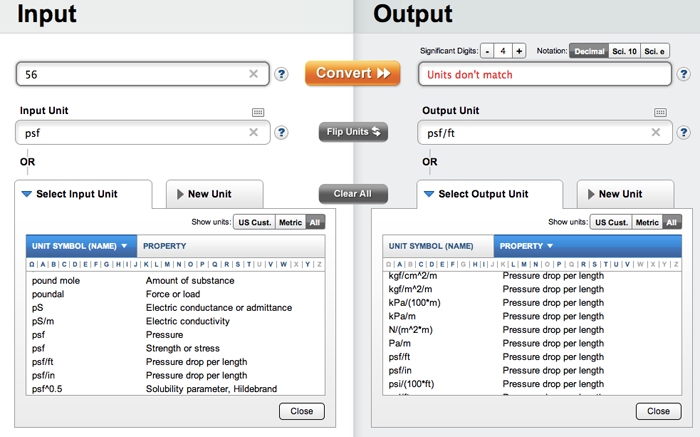
Please note: The Unit Converter will display an error message in the 'Output' value field after you click 'Convert >>' if the units you're converting to and from are units representing different properties.

If you inadvertently enter an undefined symbol into the 'Input Unit' field, the Unit Converter will display an error message in the 'Output' value field after you click the 'Convert >>' button.
List of Supported Math Operators and Functions
The list below shows all the supported math operators and functions:
Operator/Symbol
Description
+
Addition
-
Subtraction
*
Multiplication
/
Division
()
parenthesis to enforce the order of the math operators
^
Exponent
abs(number)
absolute value
sin(number)
Sine
asin(number)
arc sine
cos(number)
Cosine
cosh(number)
hyperbolic cosine
coth(number)
hyperbolic cotangent
csc(number)
Cosecant
csch(number)
hyperbolic cosecant
acos(number)
inverse cosine
tan(number)
Tangent
atan(number)
inverse tangent
sqrt(number)
square root
exp(number)
exponential function raised to the power number
ln(number)
natural logarithm
log10(number)
base 10 logarithm of number
random(number)
the random number from 0 to the arguments value
Functionality for Knovel subscribers
The Knovel Unit Converter is available in two modes. Non-subscribers get a free-to-use and share tool with access to approximately 1,000 built-in units for use with over 80 engineering properties. Knovel subscribers get additional customization functionality. They can save and access user-created units, mark and sort favorite units, and create their own default settings.
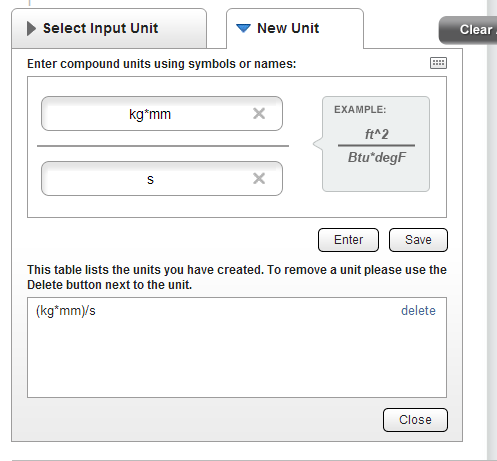
- Click the down arrow to open the 'New Unit' tab.
- Enter the desired unit (kg*mm/s in the example above), making sure to use both the Numerator (kg*mm) and Denominator fields.
- Click 'Save.' The new unit will appear in the table below the Numerator and Denominator fields associated with the 'My Units' property and marked with a person icon. It will also appear in the list of units in the 'Select Input Unit' tab.
- To delete the unit, click 'Delete' and it will be removed from the list.
Please Note: Should you attempt to create a unit that already exists, you'll receive a message stating 'This unit is already available in the list of units'.
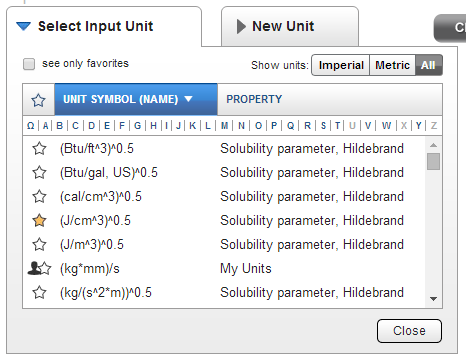
- Mark a unit as favorite by clicking the white star icon next to the unit. The icon will change color to yellow. See the example above, unit (J/cm^3)^0.5.
- De-mark a favorite unit by clicking the yellow star.
- Sort favorites in ascending/descending order by clicking the star button to the left of the 'UNIT SYMBOL (NAME) ' button.
- Click the ' see only favorites ' checkbox to filter and display only your favorite units.
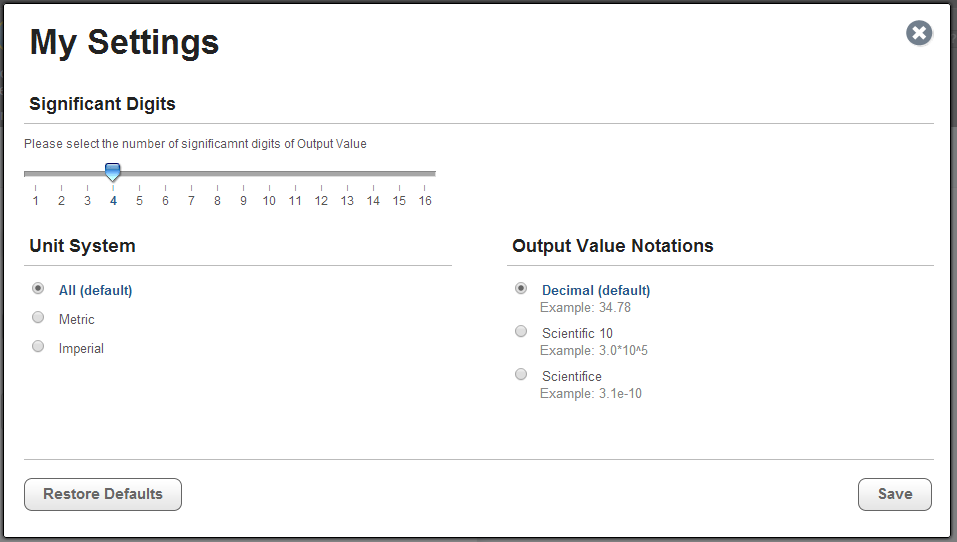
As a subscriber, you can create default settings for the following elements:
- Significant digits
- Unit System
- Output Value Notations
- Click 'My Settings'.
- Select your desired settings from the list of options for each element, as illustrated in the example above.
- Click 'Save'.
Did we answer your question?
Related answers
Recently viewed answers
Functionality disabled due to your cookie preferences